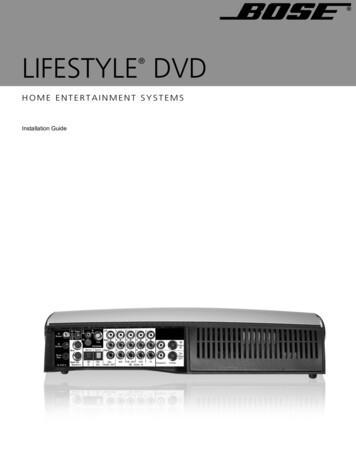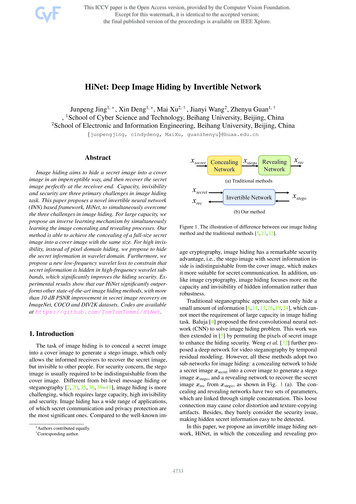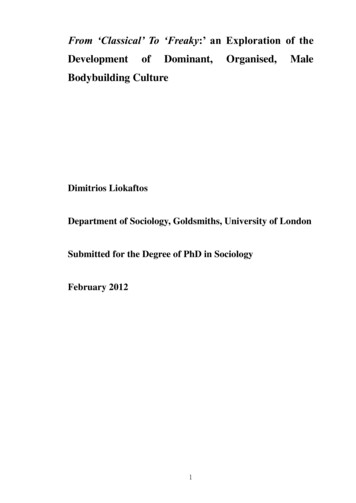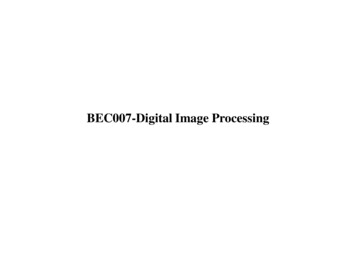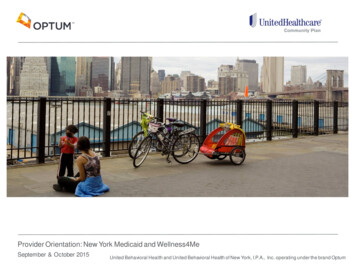
Transcription
Title page withmedical imageProvider Orientation: New York Medicaid and Wellness4MeSeptember & October 2015United Behavioral Health and United Behavioral Health of New York, I.P.A., Inc. operating under the brand Optum
Today’s speakers Joyce B. Wale, LCSW, Executive Director, Behavioral Health Lisa Camardo, Director of NY Behavioral Health Operations Lana Kats, MBA, Director of Network Management for NY Public Sector Adrene Cohen, RN, MA, MPA, FACHE, Northeast Regional Director,Accountable Care Programs and Health Homes Seth Mandel, MD, MBA, Behavioral Health Medical Director, Wellness4Me Peg Elmer, LCSW, Clinical Director, Wellness4Me Margaret Sullivan, RN, MSN, Clinical Director, Mainstream Medicaid Barbara Tedesco, MS, CRC, Recovery and Resiliency Manager Gayle Parker-Wright, LCSW-R, Network Trainer Eunice Hudson, Provider Education Specialist Allandro Pierre, MHA, Network Manager Missy Lerma, LCSW, Director of Network Management2
Agenda Welcome and Introduction Overview of Optum and UnitedHealthcare Community Plan Health Homes Benefits Clinical Vision Clinical and Utilization Management Requirements Cultural Competency Quality Improvement Credentialing and Recredentialing Recovery and Resiliency Billing Provider Express and UnitedHealthcare Online Network Services3
UnitedHealthcare Community PlanUnitedHealthcare Community Plan (Community Plan) Is the largest health benefits company dedicated to providing diversifiedsolutions to states that care for the economically disadvantaged, the medicallyunderserved and those without benefit of employer-funded health carecoverage Participates in programs in 24 states plus Washington D.C. servingapproximately 5 million beneficiaries of acute and long-term care Medicaidplans, the Children’s Health Insurance Program (CHIP), Special Needs Plansand other federal and state health care programs Health plans and care programs are uniquely designed to address the complexneeds of the populations they serve, including the chronically ill, those withdisabilities and people with higher risk medical, behavioral and social conditions4
Introduction to OptumUnited Behavioral Health (UBH) was officially formed on February 2,1997, via the merger of U.S. Behavioral Health, Inc. (USBH) and UnitedBehavioral Systems, Inc. (UBS)United Behavioral Health, operating under the brand Optum, is a whollyowned subsidiary of UnitedHealth Group–Optum is a health services business–You will see UBH, UBH I.P.A. and Optum in our communications to youWe are dedicated to making the health system better for everyone.For the individuals we serve, you play a critical role in our commitmentto helping people live their lives to the fullest.5
Our United Culture6
Managed care transition The NYS Office of Mental Health (OMH) is collaborating with theDepartment of Health (DOH) and Office of Alcoholism and SubstanceAbuse Services (OASAS) to implement the managed care transition inresponse to the recommendations and guiding principles set forth bythe Medicaid Redesign Team (MRT) Behavioral Health (BH)Subcommittee The vision is to create a system that provides New Yorkers with fullyintegrated behavioral and physical health services offered within acomprehensive, accessible and recovery oriented system– For adults 21 and older, the integration of all Medicaid behavioral health (BH)and physical health (PH) benefits under managed care will go into effectOctober 2015 in NYC and on July 2016 in the rest of New York State andwill be delivered through two BH managed care models7
Managed care transition, continuedManaged care models: Qualified Mainstream Managed Care Organizations (MCOs): For all adultsserved in mainstream MCOs throughout the State, the qualified MCO willintegrate all Medicaid State Plan covered services for mental illness, substanceuse disorders (SUDs), and physical health conditions Health and Recovery Plans (HARPs): HARPs will manage care for adults withsignificant behavioral health needs– They will facilitate the integration of physical health, mental health, andsubstance use services for individuals requiring specialized expertise, tools,and protocols which are not consistently found within most medical plans– In addition to the State Plan Medicaid services offered by mainstream MCOs,qualified HARPs will offer access to an enhanced benefit package comprisedof Home and Community Based services (HCBS) designed to provide theindividual with a specialized scope of support services not currently coveredunder the State Plan8
Managed care transition, continuedThe Managed Care System is being developed based on the MedicaidRedesign Team (MRT) guiding principles Person‐Centered Care management Integration of physical and behavioral health services Recovery oriented services Patient/Consumer Choice Ensure adequate and comprehensive networks Tie payment to outcomes Track physical and behavioral health spending separately Reinvest savings to improve services for BH populations Address the unique needs of children, families & older adults9
Wellness4Me (Health and Recovery Plan, HARP): phase 1 Starting October 1, 2015 both the Mainstream Medicaid and Wellness4MePlan (HARP) benefits will be rolled out These products are for members who are 21 years and older residing in the 5boroughs of New York City– It will be phased in over a 3 month period Home and Community Based Services (HCBS) for Wellness4Me members willbegin January 1, 2016 Membership by Borough / County– Bronx Bronx County– Brooklyn Kings County– Queens Queens County– Manhattan New York County– Staten Island Richmond County10
Wellness4Me Plan (HARP): phases 2 & 3Phase 2 July 1, 2016: includes all adults 21 years old, in the rest of state– All New York State, eligible adults 21 and older, who meet the criteria can be enrolledin the Wellness4Me PlanPhase 3 January 1, 2017: all adults under 21 years old, adolescents and children inNew York City (5 Boroughs), Nassau and Suffolk July 1, 2017: all adults under 21 years old, adolescents and children in the restof state11
Understanding Wellness4Me Wellness4Me is a new UnitedHealthcare Community Plan product for HARPeligible members A member cannot be enrolled in the UnitedHealthcare Wellness4Me Plan and aManaged Medicaid Plan – The member must choose one plan The member must clinically qualify for Wellness4Me Plan based on the resultsof the New York State (NYS) Community Mental Health Assessment (needsassessment) NYS will “passively” enroll Community Plan members into the Wellness4MePlan based on diagnosis and claims history Members can “opt out” of joining the Wellness4Me Plan and enroll in theManaged Medicaid plan within the first 90 days of enrollment Members can dis-enroll from either benefit within the first 90 days of enrollment– After 90 days, members must have a good reason to dis-enroll (e.g., moved out of theservice area)12
Wellness4Me Health Homes and CareCoordinationAdrene Cohen, RN, MA, MPA, FACHE, Northeast Regional Director,Accountable Care Programs and Health Homes
Wellness4Me Care Coordination and Health HomesHealthHomeWellness4MeServicesIntegrateNew York Health Home14
Populations Health Homes serve Individuals who are experiencing a severe disability or mentalillness High risk homeless Medication Assisted Therapy (MAT) Members seeking permanent housing and a sense of community Transition from jail/prison Court-ordered community dwellers Members with complex medical conditions such as obesity,diabetes, asthma, HIV, congestive heart failure, etc.15
What is a Health Home?The six (6) core Health Home functions mandated by the Patient ProtectionAct are:Operational PrioritiesMedicalBehavioral SocialTransition of careXXXCare coordinationXXXReferral managementXXXIndividual careXXXHealth promotionXXXCare support forfamily/caregiverXXX16
Overview of the processMemberEnrollmentAssignedPCPAssigned BHProviderHARP CareCoordinatorCare Coordinatorat Health HomeBH CareCoordinators17
Care Coordination Care Coordination will include:– Documentation of a Plan of Care by the behavioral and medical care team inone document– The Care Plan will indicate the activities and strategies to achieve stated caregoals for the member– The interdisciplinary team that is created from the collaboration amongproviders facilitates the integration of care18
DocumentationDocumentation will reside in a platform that is shared and provides reports The reports will facilitate tracking of– Referrals– Met/unmet goals– Appointments scheduled 90 days post hospitalization or emergencydepartment visit– Hospitalizations or emergency department visits and 7 day follow-up– High-risk comorbid members for hospital avoidance– Alerts and other activities19
Goals of Health Homes To use data to monitor member’s status To avoid service duplication To identify members who require care coordination or HARP services upondischarge To identify members who have not seen their PCP/Health Homes To create metrics that facilitate monitoring and evaluation To reduce cost20
UnitedHealthcare Accountable Care TeamProgram Managers are Registered Nurses Work on care transitions Work with Community Health Workers (CHWs) to engage memberswith a Health Home Train Health Homes/Coordination Management Agencies (CMAs) incare needs and provider contact21
Wellness4Me, Mainstream Medicaid and BenefitsLana Kats, MBA, Director of Network Management for NY Public Sector
Wellness4Me Plan (HARP) and Mainstream Medicaid23
Membership cards: New York Medicaid, front of card24
Membership cards: New York Medicaid, back of card25
Wellness4Me Plan (HARP) vs. Behavioral Health BenefitThe Home andCommunity BasedServices are ONLYavailable tomembers enrolled inWellness4Me Plan(HARP).HCBS will not startuntil 1/1/2016to allow time for all HARPmembers to receive theirfull assessment andfor Plans of Care to bedocumented.26
Membership cards: New York Wellness4Me, front of card27
Membership cards: New York Wellness4Me, back of card28
Clinical VisionSeth Mandel, MD, MBA, Behavioral Health Medical Director, Wellness4Me
Our Clinical VisionCare AdvocacyThe purpose of Care Advocacy is intervention on behalf ofindividuals living with a health issue. We improve theexperience of individuals we serve, using a range of toolsand resources. We are dedicated to recovery, resiliency,wellness and wellbeing provided at the highest quality andmost cost-effective manner.Service System SolutionsInformation Managementand TechnologyThe purpose of Service SystemManagement is to improve thestructure of, access to andpractice within systems of care.We build relationships within localcommunities to learn about andimprove healthcare systems.The purpose of InformationManagement and Technology isto create a more engaging,effective and affordablehealthcare experience and toempower individuals in theirpursuit of well-being.30
Our goalsRecovery Focus Apply recovery principles from first callthrough natural community supports Support use recovery language and principlesin every aspect of our work Right care at the right timeImproveAccess to Care Collaborate with providers to ensure timelyaccess to services Increase community-based servicesIntegrate PhysicalandBehavioral Health No wrong door access to care Eliminate silos through integrated personcentered care plans Broaden provider focus for integrating care Reduce readmissions to inpatientReduce Cost Engage community based crisis stabilizationand use of PCP services Increase use of natural community supports31
Tools for system transformationUtilizationManagement Review requests forservice againstLOCG’s /LOCADTR:– Prior Notification– Pre-Certification– Prior Authorization– Concurrent Review– Transition Planningfor successfuldischargeCareCoordination Follow-up supportafter discharge Risk assessment andsafety planning Coordination withcommunity resources Support member’srecovery goals Engagement ofmember, family, andother support systemsin development ofcare planPerson-CenteredCare Align closely withHealth Home andAccountable CareTeamsQuality DrivenOutcomes Team-FacingMeasures:– Call quality Care plans include:– Inter-rater reliabilitymeasures– Strength-basedassessment,including culture PerformanceImprovement Projects– Measurable/attainable/realistic/timelyobjectives Provider/Member Facing Measuresinclude HEDIS/NCQA– Keeps the personin context of theirenvironment andnatural supports HCBS Special Populations32
Clinical and Utilization Management RequirementsPeg Elmer, LCSW, Clinical Director, Wellness4MeMargaret Sullivan, RN, MSN, Clinical Director, Mainstream Medicaid
Frequently used acronyms ACT: Assertive Community Treatment CDT: Continuing Day Treatment SPOA: Single Point of Access PROS: Personalized Recovery Oriented Services– ISR: Initial Service Recommendation– IRP: Individualized Recovery Plan– IR: Intensive Rehabilitation– ORS: Ongoing Rehabilitation and Supports– CRS: Community Rehabilitation and Support OTP: Opioid Treatment Program LOCADTR: Level of Care for Alcohol & Drug Treatment Referral34
Ambulatory behavioral health services Assertive Community Treatment (ACT) OMH Clinic services Continuing Day Treatment (CDT) Comprehensive Psychiatric Emergency Program (CPEP) Intensive Psychiatric Rehabilitation Treatment (IPRT) Partial Hospitalization Personalized Recovery Oriented Services (PROS) Transportation Crisis Intervention35
Authorization requirements: mental health36
Authorization requirements: PROS37
Authorization requirements: substance use disorders38
Utilization managementPrior Authorization Inpatient Mental Health Inpatient SUD: Medically Managed Detox Inpatient Rehab Outpatient Mental Health: PHP, IOP, ECT,PROS, CDT, ACT, Psychological TestingConcurrent Review Inpatient: review is due on the lastcovered day Outpatient: updated clinical is due beforethe last covered day SUD: Residential RehabDischarge Review Discharge date, medications anddisposition Follow-up appointment within 7 days(inpatient level of care)Retrospective Review Conducted for all covered levels of carefor members who are eligible for benefitsduring the identified dates of service Must be requested within 120 days Identification of biopsychosocial needsand follow-up (housing, medical, etc)39
Level of care guidelines Where can providers find level of care guidelines?Mental HealthProvider Express: providerexpress.com Provider Manual Final LOCG’s pending NYSapprovalSubstance Use DisordersLevel of Care for Alcohol and DrugTreatment Referral (LOCADTR)NY LOCADTR 3 https://extapps.oasas.ny.gov40
Level of Care Guidelines (LOCG): provider resource Common Criteria for Guidelines- commitment of NYS and MCO’s to decreaseprovider burden Your homework assignment: review all relevant LOCGs LOCGs will be posted to Provider Express- visit this site frequently for updatesand valuable information LOCGs are reviewed and updated annually Use it to train staff Many of these guidelines are pending review and approval by NYS Understanding how to use these guidelines as a clinical tool can greatlyimprove your managed care experience41
Level of Care Determinations SUD: LOCADTR Designed for substance abuse treatment providers, the LOCADTR assistsproviders in making decisions about the appropriate level of care for a member The LOCADTR is meant to ensure that all members in need of treatment for asubstance use disorder have access to care and are placed in the leastrestrictive, but most appropriate level of care available In addition to helping providers and members, the data collected by the tool willalso be studied and analyzed to provide further insights into its effectivenessand allow for adjustments and updates to be made Level of care is determined by a variety of factors, including:– Diagnostic information (for example, the number of DSM-5 criteria the member meets)– Assessment of the member’s need for crisis or detoxification services (for instance,determining possible medical complications from withdrawal)– Risk factors (such as the presence of severe medical and psychiatric conditions)– Resources available to the member (for example, a social or family network who aresupportive of recovery goals)42
Inpatient Substance Use Disorder (SUD) reviews Provider’s are required to submit clinical information via UnitedHealthcareOnline Provider Portal Include a PDF file of the LOCADTR report with the clinical documentation Our Facility Based Care Advocates (FBC-A) will review clinical information andenter it in LOCADTR When the Level of Care is consistent with the provider report, services areauthorized If the LOCADTR Level of Care is not consistent with the request, our FBC-A willcall the provider to request additional clinical information Any overrides in LOCADTR require clinical justification: if you select an overrideyou can anticipate a call from our FBC-A to substantiate the request43
Override options It is extremely important that providers document relevant information tosubstantiate an override Indicating that this level of care is not available within your service deliverysystem does not substantiate an override44
Medical necessityCare Advocates use the Level of Care Guidelines when making medicalnecessity determinations and as guidance when providing referral assistance.Generally acceptedstandards of practiceClinically appropriate Based on crediblescientific evidence Generally recognizedby the relevant medicalcommunity Use evidenced-basedoutcomes to validatethe practice Type, frequency,extent, and duration ofservices Considered effectivefor the treatment ofmental illness,substance usedisorder, or associatedsymptomsDeterminations ofmedical necessity Informed by Unique aspects ofthe case Member’s benefitplan Available services Ability of provider tomeet the member’simmediate needs Alternatives that existin the service area45
What happens if medical necessity is not met? If a clinical review results in a disagreement about level of care there are a fewoptions:– Peer Review Full denial Partial denial– Appeals When a determination is made that a level of care is not the right care at theright time we will:– Work closely with providers to identify a transition plan– Assist provider and members in finding services that meet the member’s needs46
Evidence-Based PracticesExamples of Evidence-Based Practices (not an all inclusive list) Motivational Interviewing Person-Centered Care Trauma Informed Care Risk Assessment and Crisis Intervention Integrated Whole Health Model Critical Time Intervention Recovery and Resiliency Individualized Recovery Planning Cognitive Behavioral Therapy Dialectical Behavioral Therapy47
Special populations Transition Age Youth (TAY)– Most vulnerable as they transition from child to adult system– Need to collaborate to identify and educate youth as they approach age 21– Identify youth that may qualify for Wellness4Me (HARP) and Health Homes Co-occurring Physical and Behavioral Health and/or SUD– Integrated models of care First episode psychosis– OnTrackNY - required tracking of first episode– Supportive Transition and Recovery Team (START)– NYS Qualified FEP Providers Opioid Dependence– Epidemic– Identifying, referring and linking members to appropriate SUD services48
Wellness4Me: HCBS covered services Psychosocial Rehabilitation Community Psychiatric Support and Treatment (CPST) Habilitation/Residential Support Services Family Support and Training (FST) Short-Term Crisis Respite Intensive Crisis Respite Education Support Services Empowerment Services – Peer Supports (OMH) Pre-Vocational Services Transitional Employment Intensive Supported Employment Ongoing Supported Employment Transportation49
HCBS utilization parametersHCBS will be subject to utilization caps at the Member level that apply ona rolling basis (any 12 month period). Tier 1 HCBS: limited to 8,000 Tier 1 and Tier 2 combined have an overall cap of 16,000Utilization caps exclude crisis respite: short-term crisis respite andintensive crisis respite are each limited within their own individual caps to7 days per episode and 21 days per yearTier 1: Employment, education and peer supportTier 2: Full array of HCBS50
Individualized Service Planning Plans of Care– Master integrated document– Includes all services: providers, frequency and duration, contact information– Ideally POC will be completed by Health Home Care Coordinators– POC must be submitted to the Plan for approval Confirming providers in network Verifying members eligibility for the services listed Evaluating POC for recovery goals that are person-centered and echo the membersgoals in their words– Our Care managers complete the POC when: Member is not enrolled or is refusing Health Home care coordination or Member is not Health Home eligible We are committed to assist members with field based care advocates, peers,community health workers and housing specialists51
Service specific plans The member's diagnosis or presenting issues warranting services The member's problems and strengths The member's service goals are consistent with the purpose and intent of theprogram Plan for the provision of additional services to support the recipient outside ofthe program Criteria for discharge planning Person-centered care planning is clear and includes– Consistent goals and objectives– Concrete and easy to understand information (who, what and when)– Evaluation of goal attainment– Proactive planning to prevent or de-escalate crisis52
HCBS eligibility53
HCBS eligibility, continued54
Cultural CompetencyGayle Parker-Wright, LCSW-R, Network Trainer
Cultural competency Cultural and linguistic competence is a set of congruent behaviors,attitudes, and policies that come together in a system, agency, oramong professionals, that enables effective work in cross-culturalsituations Competence means having the capacity to function effectively as anindividual and an organization within the context of the cultural beliefs,behaviors, and needs presented by members and their communities56
Cultural competency, continued Culture refers to integrated patterns of human behavior within various racial,ethnic, religious or social groups, including:– Language– Thoughts– Communications– Actions– Customs– Beliefs– Values– Institutions57
Importance and value of cultural competence Given the diverse ethnic population in New York, providers must be prepared toprovide culturally appropriate services Service settings and approaches should be culturally sensitive to engageindividuals from diverse backgrounds to access services Promoting open discussions about mental health or substance abuse issues isan important step to reduce the stigma many individuals have Emphasizing individualized goals and self-sufficiency encourages members tolive their lives to the fullest58
Quality ImprovementMissy Lerma, LCSW, Director of Network Management
Quality improvementQuality of care is measured andmonitored throughout the organization.Examples of how we measure quality:HEDIS –measures– Complaints– Sentinel Events– Provider Satisfaction Surveys– Member Satisfaction Surveys– Coordination of Care– Best Practice GuidelinesAdherenceto lEventsHEDISQARRAudits60
NCQA & HEDIS What is NCQA?National Committee for Quality Assurance What is HEDIS?Healthcare Effectiveness Data and Information SetA tool used by more than 90% of America’s Health Plans to measureperformance on important dimensions of care and service.61
Examples of behavioral health HEDIS measuresFUH –Follow-up AfterHospitalizationFUHADD –Follow-up care forChildren prescribedADHD MedicationHEDISAMM –AntidepressantMedicationManagementAMMADD62
Member complaintsAs an organization we investigate all member complaints (also known asgrievances)Complaints may be reported indifferent ways:Providers are part of theinvestigative process– Information is provided by themember and/or family member tothe Health Plan or other internaldepartment that reports cases– Submit medical records forreview– Member direct report throughcalling the Health Plan CustomerService Department– Cooperate as necessary toresolve the investigation– Provide a response to anallegation63
Sentinel EventsWhat is a Sentinel Event?Sentinel events are defined as a serious, unexpected occurrence involving a Member thatis believed to represent a possible quality of care issue on the part of the practitioner/facilityproviding services, which has, or may have, deleterious effects on the Member, includingdeath or serious disability, that occurs during the course of a Member receiving behavioralhealth treatment.Reporting Sentinel Events to Quality: If you are aware of a sentinel event involving a Member, you must notifyUnitedHealthcare Community Plan within one business day of the occurrence Standardized reporting forms (located here on Provider Express) should be sent directlyto the Quality Department through secure fax or email: Fax: 844-342-7704 – Attn: Quality Department Email: NYBH QIDept@uhc.com Additional information about Sentinel Events can be found in the Behavioral HealthProvider Manual64
AppealsAn Appeal is any of the procedures that deal with the review of adversedeterminations on the health care services a Member is entitled to receive or anyamounts that the Member must pay for a covered service.All Appeals should be submitted to:UnitedHealthcare Community Plan AppealsP.O. Box 31364Salt Lake City, UT 84131-0364For questions about Appeals, you may call 866-362-336865
Provider quality audits Provider audits are completed for a variety of reasons:– On-going monitoring of providers, including Home and Community Based Servicesproviders– At the time of Credentialing and Recredentialing for providers without OMH/OASAScertification and without a national accreditation (for example, The Joint Commission orCARF)– Quality of Care (QOC) investigation– Investigation of member complaints regarding the physical environment of an office oragency66
Provider quality audits, continuedElements reviewed during audits Physical environment Policies and procedures Member treatment records Personnel filesScoring of Audits 85% and higher is passing Scores between 80 – 84% require a Corrective Action Plan (CAP) Scores below 79% require a CAP and re-audit67
Audit tools There are 8 audit tools for New York Medicaid:– Organizational Provider Site Audit Tool– Treatment Record Review Tool– HCBS Record Tool– Case Management Record Tool– Psychosocial Rehab Record Tool– Peer Support Record Tool– Clinician Site Audit Tool– Home Office Site Audit Tool The audit tools will be posted to providerexpress.com once they are finalized:from the home page, choose Our Network Welcome to the Network NewYork Quality Improvement Audit Tool Names68
Documentation standards Information regarding documentation standards for behavioral healthproviders can be located in 3 places:– The Optum Network Manual (located on providerexpress.com): from thehome page, choose Clinical Resources Guidelines/Policies & Manuals Optum Network Manual Treatment Record Documentation Requirements– The New York Mainstream Medicaid and Wellness4Me Behavioral HealthProvider Manual (Coming Soon, will be located on Provider Express: fromthe home page choose Our Network Welcome to the Network New York NY Medicaid Behavioral Health Provider Manual)– The audit tools69
Documentation standards, continuedHighlights of documentation standards Record must be legible All entries must be signed by the rendering provider Entries must include the start and stop time or length of time spent in thesession (for timed sessions) A Psychiatric and medical history, including the presenting problem, isdocumented Risk assessments (initial and on-going), including safety planning whenapplicable are present A Substance abuse screening is completed For children and adolescents, a complete developmental history is documented70
Documentation standards, continued Treatment planning documentation includes– Short- and long-term goals that are objective and measurable– Time frames for goal attainment– Updates to the plan when goals are achieved or new issues are identified– Modifications to goals if goals are not achieved For members that are prescribed medications documentation includes– The date of the prescription, along with dosage and frequency– Rationale for medication adjustments– Informed consent for medications– Education regarding the risks/benefits/side-effects/alternatives71
Documentation standards, continued Coordination of care is completed (and documented) with Primary CarePhysicians Coordination of care is completed (and documented) with other treatingproviders If the member refuses to allow coordination to occur, that is clearly documentedin the treatment record Discharge planning should be on-going and a discharge summary isdocumented when services are completed Medical necessity for services that are rendered is clearly documented72
Provider quality audits, continuedFeedback to providers Feedback is provided verbally at the conclusion of the audit A written feedback letter is mailed within 30 days for routine audits; for Qualityof Care audits, the feedback letter is mailed after the requesting committeereviews the audit results When a Corrective Action Plan is required, it must be submitted within 30 daysof the request Re-audits are completed within 3-6 months of acceptance of the CorrectiveAction Plan73
Cre
Membership by Borough / County – Bronx Bronx County – Brooklyn Kings County – Queens Queens County – Manhattan New York County – Staten Island Richmond County


